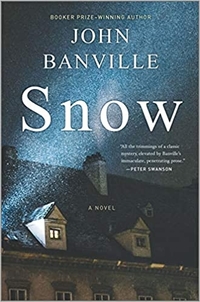The Singularities by John Banville
 Wednesday, October 26, 2022 at 6:36AM
Wednesday, October 26, 2022 at 6:36AM 
Published by Knopf on October 25, 2022
John Banville (at least when he writes under his own name) is among the greatest of the Irish prose stylists. He’s also a thinker who brings an element of playfulness to deep thought. Banville’s thoughts in The Singularities turn to the nature of reality, a question that joins philosophy and science. The novel seems to suggest that reality is what we make it. If that’s true, we should make it carefully.
Two narrative voices in The Singularities alternate and sometimes merge. One voice belongs to Professor Jaybee, who has been engaged to write a biography of the mathematician Adam Godley, creator of the Brahma Theory, a “dazzling re-statement of the fundamental nature of reality.” One component of the theory holds that any attempt to understand the universe contributes to its destruction. People literally deconstruct the universe by trying to comprehend its reality. That discovery gave birth to a ban on scientific inquiry, a shuttering of the science and math departments in universities. The theory also seems to have affected reality in an undefined way. New York is again New Amsterdam. The plague may have returned to Venice. A Manhattan and an Old Fashioned are now the same drink.
The other narrative voice tells the story in the third person. That narrator describes itself as a minor god or godlet, a child of Zeus. An omniscient entity is well positioned to follow a murderer once known as Freddie who took the name Felix Mordaunt after his release from prison. Yet the two narrators are not so different; when characters speak to the godlet, they seem to be looking at Jaybee. The only character who can see the godlet is a dog.
In postmodern fiction, anything goes — the more confusing, the better. One might assume that the godlet is John Banville, but who knows? Given the initials that combine in Jaybee’s name, a reader might also conclude that Jaybee is Banville. Perhaps the point is that every character in a novel is really the author, for characters do not exist until the author creates them. Or perhaps the nature of reality is that, at some level, we are all the same person traveling the same course we have traveled throughout the infinity of time, even if we believe ourselves to be individuals with free will and uncertain futures. “For nothing exists by itself, in isolation; there is only the continuum, in which everything presses into, bites into and extends from, everything else.”
Speaking of confusion, the novel warps the literary illusion of reality by bringing together characters and settings from Banville’s earlier work. Freddie murdered a maid in The Book of Evidence. He visits a resort that was featured in The Sea. The Godleys, Ivy Blount, and Duffy the cowman appeared in The Infinities. I’m sure there are other examples (I haven’t read everything Banville has written); those were the easiest for me to spot.
The confusion of reality and illusion is evident when Jaybee believes he sees Godley’s dead daughter Petra, or her ghost, and when Godley in his old age travels to Venice and wonders whether a woman named Cissy actually exists, whether Cissy is a projection of Petra, whether he is actually in Venice or inhabiting a dream. When Godley wakes from dreams, the real world he encounters seems like another dream. Perhaps the reality we all believe we experience is nothing but a dream. Perhaps being awake is just “another kind of sleep.” On the other hand, another character tells Jaybee that the letter in which Godley expressed those thoughts is just another of his lies. Reality, illusion, fiction, truth, lie — all inseparable and indistinguishable. Or not.
The Singularities is more a challenging work of philosophy than a traditional novel. Before letting it go, Banville begins to construct a plot with Felix’s release from prison and his travel to the house where he lived while growing up, in a place that is now unrecognizable to him because time has passed and reality has changed. Jaybee’s agreement to investigate and write about Godley’s life seems to furnish the second plot element. He meets characters who knew Godley, including his widow, whose dementia has altered her reality.
Jaybee apparently finishes a chapter of the biography; Banville sticks it into the middle of The Singularities. After that, any attempt at plotting is all but abandoned, as the story follows tangents related to Godley, all but forgetting Felix’s role in the novel.
So what’s left? Astonishing prose is the reward for sticking with the novel. One of the narrators of The Singularities describes an evening in New Amsterdam: “We had booze, broads, a barroom fight and a night in the cells, and in the morning a crapulous and shamefaced court appearance, followed by summary deportation and a thunderous warning never to show our faces in town again. No, of course we didn’t; honestly, you’d believe anything.” It is worth suffering the confusion of reading The Singularities just to encounter such passages. Some readers might find it worth reading twice to gain a more nuanced understanding of the points Banville is making, although it might be necessary to read or reread everything Banville has written to appreciate the novel in full. Lacking that kind of ambition, once was enough for me, coupled with my dim memories of the other Banville novels I’ve read. I wouldn’t rate The Singularities as my favorite of those (The Book of Evidence probably earns that honor), but I enjoyed nearly every page.
RECOMMENDED
